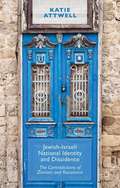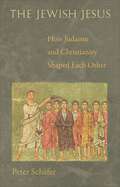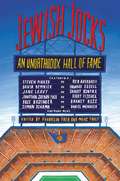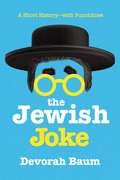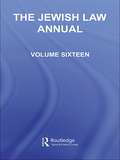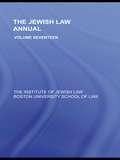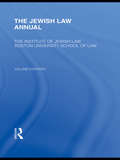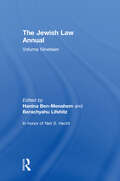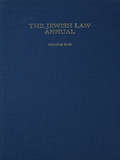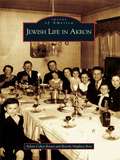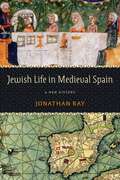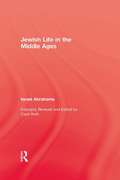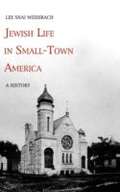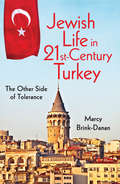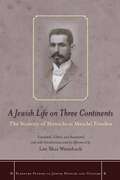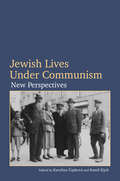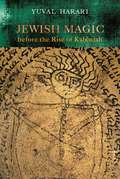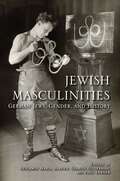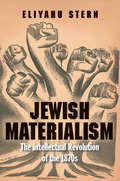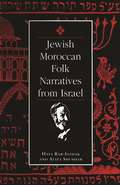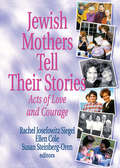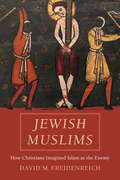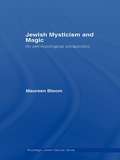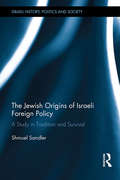- Table View
- List View
Jewish-israeli National Identity And Dissidence
by Katie AttwellThis unique book provides a critical perspective on identity in questioning how Israeli Jews manage and manifest their concern for the Palestinian Other, eschewing presenting identities as concrete and, rather, examines their creation through discourse. Zionism and the Israeli state have constructed a Jewish national identity premised on demonisation of the Other. This book explores how internal critics use alternative discourses of identity to re-imagine this Jewish-Israeli national identity, and considers how they might fail. It combines a rigorous theoretical analysis of nationalism with an engaging examination of the identifications and contradictions of eleven Jewish-Israeli individuals. Featuring, among others, high profile journalist Gideon Levy, veteran maverick Uri Davis and literary novelist Dorit Rabinyan, Attwell provides a revealing insight into national identity, political dissent, conflict and resistance.
The Jewish Jesus: How Judaism and Christianity Shaped Each Other
by Peter SchäferHow the rise of Christianity profoundly influenced the development of Judaism in late antiquityIn late antiquity, as Christianity emerged from Judaism, it was not only the new religion that was being influenced by the old. The rise and revolutionary challenge of Christianity also had a profound influence on rabbinic Judaism, which was itself just emerging and, like Christianity, trying to shape its own identity. In The Jewish Jesus, Peter Schäfer reveals the crucial ways in which various Jewish heresies, including Christianity, affected the development of rabbinic Judaism. He even shows that some of the ideas that the rabbis appropriated from Christianity were actually reappropriated Jewish ideas. The result is a demonstration of the deep mutual influence between the sister religions, one that calls into question hard and fast distinctions between orthodoxy and heresy, and even Judaism and Christianity, during the first centuries CE.
Jewish Jocks: An Unorthodox Hall of Fame
by Franklin Foer Marc TracyJEWISH JOCKS: AN UNORTHODOX HALL OF FAME is a timeless collection of biographical musings, sociological riffs about assimilation, first-person reflections, and, above all, great writing on some of the most influential and unexpected pioneers in the world of sports. Featuring work by today's preeminent writers, these essays explore significant Jewish athletes, coaches, broadcasters, trainers, and even team owners (in the finite universe of Jewish Jocks, they count!).Contributors include some of today's most celebrated writers covering a vast assortment of topics, including David Remnick on the biggest mouth in sports, Howard Cosell; Jonathan Safran Foer on the prodigious and pugnacious Bobby Fischer; Man Booker Prize-winner Howard Jacobson writing elegantly on Marty Reisman, America's greatest ping-pong player and the sport's ultimate showman. Deborah Lipstadt examines the continuing legacy of the Munich Massacre, the fortieth anniversary of which coincided with the 2012 London Olympics. Jane Leavy reveals why Sandy Koufax agreed to attend her daughter's bat mitzvah. And we learn how Don Lerman single-handedly thrust competitive eating into the public eye with three pounds of butter and 120 jalapeño peppers. These essays are supplemented by a cover design and illustrations throughout by Mark Ulriksen.From settlement houses to stadiums and everywhere in between, JEWISH JOCKS features men and women who do not always fit the standard athletic mold. Rather, they utilized talents long prized by a people of the book (and a people of commerce) to game these games to their advantage, in turn forcing the rest of the world to either copy their methods-or be left in their dust.
The Jewish Joke: A Short History--with Punchlines
by Devorah BaumHeard the one about the Rabbi and the cow from Minsk? Look no further than this witty compendium, a fascinating and revealing celebration of the great Jewish Joke. Comedy is full of famously funny Jews, from Groucho Marx to Sarah Silverman, from Larry David to Jerry Seinfeld. This smart and funny book includes tales from many of these much-loved comics, and will appeal to their broad audience, while revealing the history, context and wider culture of Jewish joking. The Jewish joke is as old as Abraham, and like the Jews themselves it has wandered over the world, learned countless new languages, worked with a range of different materials, been performed in front of some pretty hostile crowds, and yet still retained its own distinctive identity. So what is it that animates the Jewish joke? Why are Jews so often thought of as ‘funny’? And how old can a joke get? The Jewish Joke is a brilliant—and laugh-out-loud funny—riff on about what marks Jewish jokes apart from other jokes, why they are important to Jewish identity and how they work. Ranging from self-deprecation to anti-Semitism, politics to sex, Devorah Baum looks at the history of Jewish joking and asks whether the Jewish joke has a future. With jokes from Lena Dunham to Woody Allen, as well as Freud and Marx (Groucho, mostly), Baum balances serious research with light-hearted humor and provides fascinating insight into this well-known and much loved cultural phenomenon.
The Jewish Law Annual Volume 16 (Jewish Law Annual #10)
by Berachyahu LifshitzVolume 16 of The Jewish Law Annual adds to the growing list of articles on Jewish Law that have been published in volumes 1-15 of this series, providing English-speaking readers with scholarly material meeting the highest academic standards. The volume contains seven articles diverse in their scope and focus, encompassing legal, historic, textual, comparitive and conceptual analysis, as well as a chronicle of cases of interest, and a survey of recent literature. Three of the articles, one of which explores references to Genesis in (western) canon law, make up a special section on the book of Genesis. The other topics covered are: suicide as an act of atonement in Jewish law; early interpretations of the Bible and Talmud as reflecting medieval legal realia; Ashkenazic codifiers in Spain; and authority, custom and innovation in the seventeenth-century Italian halakhic encyclopedia, Pahad Yitzhak.
The Jewish Law Annual Volume 17 (Jewish Law Annual)
by Berachyahu LifshitzVolume 17 of The Jewish Law Annual adds to the growing list of articles on Jewish law that have been published in volumes 1-16 of this series, providing English-speaking readers with scholarly articles presenting jurisprudential, historical, textual and comparative analysis of issues in Jewish law. The volume contains seven articles diverse in their scope and focus. Two articles are devoted to the halakhic thought of Rabbi A. I Kook; two treat classic legal questions: breach of a promise to marry, and the legal capacity of minors; two examine aspects of the judicial process, one exploring talmudic analyses of the biblical requirement that courts be established in every town, and the other, post-talmudic views on judicial authority in cases suspected of fraudulent claims. Another article addresses the fascinating question of the epistemic-pedagogic worldviews of the rival Tannaitic legal academics, the House of Hillel and the House of Shammai. The volume concludes with a section on Israeli legislation that adduces or is informed by Jewish law, and two reviews of a much-discussed recent book on a topic of considerable contemporary interest: the agunah problem.
The Jewish Law Annual Volume 18 (Jewish Law Annual #18)
by Berachyahu LifshitzVolume 18 of The Jewish Law Annual contains six comprehensive articles on various aspects of Jewish law. Three articles address family law. One addresses the painful issue of the plight of the wife whose husband withholds conjugal relations. In a marriage where relations are withheld, the wife may seek a divorce, while her husband may withhold divorce. Prolonged withholding of divorce renders the wife an agunah, that is, a wife chained to a dead marriage and unable to start anew and rebuild her life. The author explores the halakhic feasibility of allowing a wife in such a predicament to bring a claim for damages against her husband for infliction of mental distress. If such claims are allowed, recalcitrant husbands may rethink their intransigence and consent to grant the divorce. Another article examines the evolution of halakhic thinking on the parent–child relationship. It traces the stages by which halakhic family law changed from a basically patriarchal system in which both mother and the child were deemed subject to the father’s will, to a more balanced system where wife and husband have equal standing with respect to custody matters, and the best interest of the child is the main consideration in custody proceedings. In another article, halakhic attitudes to corporal punishment of children are analyzed. The author explores whether the "Spare the rod and spoil the child" adage, which is based on a verse from Proverbs, indeed reflects the position of Jewish law. He shows that in fact, while recourse to corporal punishment for educational purposes is permitted--subject to detailed qualifications that greatly limit its scope--two divergent approaches to corporal punishment can be discerned in the halakhic sources. One maintains that administration of corporal punishment can be a useful pedagogic tool of last resort, whereas the other seeks to minimize recourse to corporal punishment in the educational context, questioning its efficacy. The article shows that in any event, the notion that corporal punishment is required by the law, as some, invoking the "spare the rod" maxim, have maintained, is by no means borne out by the halakhic literature. The volume also features a fascinating article on the history of two societies founded in London to further the study of Jewish law using modern scholarly methodologies. One society was active at the end of the 1920s and beginning of the 1930s, the second was active a decade later. The article explains the background to the establishment of the societies and analyzes the societies’ objectives, leaders and memberships. Both societies were founded with the intention of reformulating the classic halakhic sources in a manner that would render them suitable for contemporary application in the nascent Jewish state. But as the author shows, ultimately much of their energy was devoted to presenting the said sources to the non-Jewish legal world, for the purpose of reciprocal enrichment and edification. Rounding out the volume are two jurisprudential studies on classic legal problems. The first explores the prohibition against seeking a second legal ruling when a ruling declaring something forbidden has been handed down. What is the scope of this rule, and in what ways does it differ from the res judicata principle in western law? The author shows that both procedural and substantive readings of the prohibition were put forward in the talmudic commentaries, and explains the jurisprudential implications of these different readings. The second article examines the question of the agent who breaches his principal’s trust, focusing on the case of the agent who executes the act he was sent to carry out, but does so for himself, rather than his principal. To what extent is he liable for ensuing damages to the principal, and is his act invariably deemed reprehensible? Another issue is the legal status of the transaction carried out by such an agent. Do the rights and obligations ge
The Jewish Law Annual Volume 19 (Jewish Law Annual #19)
by Berachyahu Lifshitz Hanina Ben-MenahemVolume 19 of The Jewish Law Annual is a festschrift in honor of Professor Neil S. Hecht. It contains thirteen articles, ten in English and three in Hebrew. Several articles are jurisprudential in nature, focusing on analysis of halakhic institutions and concepts. Elisha Ancselovits discusses the concept of the prosbul, asking whether it is correct to construe it as a legal fiction, as several scholars have asserted. He takes issue with this characterization of the prosbul, and with other scholarly readings of Tannaitic law in general. The concepts of dignity and shame are addressed in two very different articles, one by Nahum Rakover, and the other by Hanina Ben-Menahem. The former discusses halakhic sources pertaining to the dignity inherent in human existence, and the importance of nurturing it. The latter presents a fascinating survey of actual legal practices that contravened this haklakhic norm. Attestations of these practices are adduced not only from halakhic and semi-halakhic documents, but also from literary, historical, and ethnographic sources. Three articles tackle topical issues of considerable contemporary interest. Bernard S. Jackson comments on legal issues relating to the concept of conversion arising from the story of the biblical heroine Ruth, and compares that concept to the notion of conversion invoked by a recent English court decision on eligibility for admission to denominational schools. An article by Dov I. Frimer explores the much agonized-over question of halakhic remedies for the wife whose husband refuses to grant her a get (bill of divorce), precluding her remarriage. Frimer’s focus is the feasibility of inducing the husband to grant the get through monetary pressure, specifically, by awarding the chained wife compensatory tort damages. Tort remedies are also discussed in the third topical article, by Ronnie Warburg, on negligent misrepresentation by investment advisors. Two papers focus on theory of law. Shai Wozner explores the decision rules–conduct rules dichotomy in the Jewish law context, clarifying how analysis of which category a given law falls under enhances our understanding of the law’s intent. Daniel Sinclair explores the doctrine of normative transparency in the writings of Maimonides, the Hatam Sofer, and R. Abraham Isaac Kook, demonstrating that although transparency was universally endorsed as an ideal, some rabbinical authorities were willing to forego transparency where maintenance of the halakhic system itself was imperiled. An article by Alfredo M. Rabello reviews the primary and secondary literature on end-of-life issues, and contextualizes the much-discussed talmudic passage bAvoda Zara 18a. And an article by Chaim Saiman offers a critical survey of the main approaches to conceptualizing and teaching Jewish law in American universities; it also makes suggestions for new, and perhaps more illuminating pedagogic direction. In the Hebrew section, an intriguing article by Berachyahu Lifshitz presents a comparison of Persian and talmudic law on the status of promises and the role of the divine in their enforcement. Yuval Sinai discusses the halakhic law of evidence, particularly the well-known "two witnesses" requirement and departures from it. The volume closes with a historical article by Elimelech Westreich on the official rabbinical court in nineteenth century Jerusalem. It focuses on the rabbinical figures who served on the court, the communities for whom it adjudicated, and its role in the broader geopolitical and sociocultural context.
The Jewish Law Annual Volume 5 (Jewish Law Annual #5)
by Bernard S. JacksonVolume 15 of The Jewish Law Annual adds to the growing list of articles on Jewish law that have been published in volumes 1-14 of this series, providing English-speaking readers with scholarly material meeting the highest academic standards. The volume contains six articles diverse in their scope and focus, encompassing legal, historical, textual, comparative and conceptual analysis, as well as a survey of recent literature and a chronicle of cases of interest. Among the topics covered are: lying in rabbinical court proceedings; unjust enrichment; can a witness serve as judge in the same case?; Caro's Shulham Arukh v. Maimonides' Mishne Torah in the Yemenite community, the New Jersey eruv wards.
Jewish Life in Akron (Images of America)
by Beverly Magilavy Rose Arlene Cohen RossenIn the mid-1800s, many Jewish families joined the western expansion and emigrated from Germany to Akron, a canal town that also had an inviting countryside. They sought economic security and religious freedom--a new start in a new town. But it was not an easy life. They organized their Jewish community into cultural and religious groups, and by the 20th century, their efforts attracted Central and Eastern European Jews with differing lifestyles. In 1929, the Akron Jewish Center opened and provided a place for all of the diverse Jewish groups in Akron to gather. It also played an enormous role in raising awareness of the richness of Jewish life in the Akron community. Jewish Life in Akron celebrates 150 years of Jewish culture, family, business, and organizational life through vintage images, many never before published, and supporting history.
Jewish Life in Medieval Spain: A New History (Jewish Culture and Contexts)
by Jonathan RayJewish Life in Medieval Spain is a detailed exploration of the Jewish experience in medieval Spain from the dawn of Sephardic society in the ninth century to the expulsion of 1492. An important contribution of the book is the integration of the rise and fall of Jewish life in Muslim al-Andalus into the history of the Jews in medieval Christian Spain. It traces the collapse of Jewish life in Muslim Spain, the emigration of Andalusi Jewry to the lands of Christian Iberia, and the long and difficult confluence of these two distinct Jewish subcultures.Focusing on internal developments of Jewish society, it offers a narrative of Jewish history from the inside out, bringing to light the various divisions and rivalries within the Jewish community. This approach, in turn, allows for a deeper understanding of the complex relations between Spanish Jews and their Muslim and Christian neighbors. Jonathan Ray’s original perspective on the Jewish experience is particularly instructive when considering the widescale anti-Jewish riots of 1391. The combination of violence and mass conversion of the Jews irrevocably shifted the dynamics of inter-religious relations as well as those within the Jewish community itself. Yet even in the wake of these tragic events, the Jews of Spain continued to flourish, fostering a culture that they would carry into exile and that would preserve the memory of Jewish Spain for centuries to come.
Jewish Life In The Middle Ages
by AbrahamsFirst published in 2010. Routledge is an imprint of Taylor & Francis, an informa company.
Jewish Life in Small-Town America: A History
by Lee Shai WeissbachLee Shai Weissbach offers the first comprehensive portrait of small-town Jewish life in America. Exploring the history of communities of 100 to 1000 Jews, the book focuses on the years from the mid-nineteenth century to World War II. Weissbach examines the dynamics of 490 communities across the United States and reveals that smaller Jewish centers were not simply miniature versions of larger communities but were instead alternative kinds of communities in many respects. The book investigates topics ranging from migration patterns to occupational choices, from Jewish education and marriage strategies to congregational organization. The story of smaller Jewish communities attests to the richness and complexity of American Jewish history and also serves to remind us of the diversity of small-town society in times past.
Jewish Life in Twenty-First-Century Turkey
by Marcy Brink-DananTurkey is famed for a history of tolerance toward minorities, and there is a growing nostalgia for the "Ottoman mosaic." In this richly detailed study, Marcy Brink-Danan examines what it means for Jews to live as a tolerated minority in contemporary Istanbul. Often portrayed as the "good minority," Jews in Turkey celebrate their long history in the region, yet they are subject to discrimination and their institutions are regularly threatened and periodically attacked. Brink-Danan explores the contradictions and gaps in the popular ideology of Turkey as a land of tolerance, describing how Turkish Jews manage the tensions between cosmopolitanism and patriotism, difference as Jews and sameness as Turkish citizens, tolerance and violence.
A Jewish Life on Three Continents: The Memoir of Menachem Mendel Frieden
by Lee Shai WeissbachThis remarkable memoir by Menachem Mendel Frieden illuminates Jewish experience in all three of the most significant centers of Jewish life during the late nineteenth and early twentieth centuries. It chronicles Frieden's early years in Eastern Europe, his subsequent migration to the United States, and, finally, his settlement in Palestine in 1921. The memoir appears here translated from its original Hebrew, edited and annotated by Frieden's grandson, the historian Lee Shai Weissbach. Frieden's story provides a window onto Jewish life in an era that saw the encroachment of modern ideas into a traditional society, great streams of migration, and the project of Jewish nation building in Palestine. The memoir follows Frieden's student life in the yeshivas of Eastern Europe, the practices of peddlers in the American South, and the complexities of British policy in Palestine between the two World Wars. This first-hand account calls attention to some often ignored aspects of the modern Jewish experience and provides invaluable insight into the history of the time.
Jewish Lives Under Communism: New Perspectives
by Katerina Capková Kamil Kijek Stephan Stach Valery Dymshits Diana Dumitru Anna Shternshis Anna Koch Agata Maksimowska David Shneer Gennady Estraikh Marcos Silber Galina Zelenina Kata BohusThis volume provides new, groundbreaking views of Jewish life in various countries of the pro-Soviet bloc from the end of the Second World War until the collapse of Communism in late 1989. The authors, twelve leading historians and anthropologists from Europe, Israel and the United States, look at the experience of Jews under Communism by digging beyond formal state policy and instead examining the ways in which Jews creatively seized opportunities to develop and express their identities, religious and secular, even under great duress. The volume shifts the focus from Jews being objects of Communist state policy (and from anti-Jewish prejudices in Communist societies) to the agency of Jews and their creativity in Communist Europe after the Holocaust. The examination of Jewish history from a transnational vantage point challenges a dominant strand in history writing today, by showing instead the wide variety of Jewish experiences in law, traditions and institutional frameworks as conceived from one Communist country to another and even within a single country, such as Poland, Czechoslovakia, Hungary, East Germany, and the Soviet Union. By focusing on networks across east-central Europe and beyond and on the forms of identity open to Jews in this important period, the volume begins a crucial rethinking of social and cultural life under Communist regimes.
Jewish Mad Men: Advertising and the Design of the American Jewish Experience
by Professor Kerri P. SteinbergIt is easy to dismiss advertising as simply the background chatter of modern life, often annoying, sometimes hilarious, and ultimately meaningless. But Kerri P. Steinberg argues that a careful study of the history of advertising can reveal a wealth of insight into a culture. In Jewish Mad Men, Steinberg looks specifically at how advertising helped shape the evolution of American Jewish life and culture over the past one hundred years. Drawing on case studies of famous advertising campaigns--from Levy's Rye Bread ("You don't have to be Jewish to love Levy's") to Hebrew National hot dogs ("We answer to a higher authority")--Steinberg examines advertisements from the late nineteenth-century in New York, the center of advertising in the United States, to trace changes in Jewish life there and across the entire country. She looks at ads aimed at the immigrant population, at suburbanites in midcentury, and at hipster and post-denominational Jews today. In addition to discussing campaigns for everything from Manischewitz wine to matzoh, Jewish Mad Men also portrays the legendary Jewish figures in advertising--like Albert Lasker and Bill Bernbach--and lesser known "Mad Men" like Joseph Jacobs, whose pioneering agency created the brilliantly successful Maxwell House Coffee Haggadah. Throughout, Steinberg uses the lens of advertising to illuminate the Jewish trajectory from outsider to insider, and the related arc of immigration, acculturation, upward mobility, and suburbanization.Anchored in the illustrations, photographs, jingles, and taglines of advertising, Jewish Mad Men features a dozen color advertisements and many black-and-white images. Lively and insightful, this book offers a unique look at both advertising and Jewish life in the United States.
Jewish Magic before the Rise of Kabbalah (Raphael Patai Series in Jewish Folklore and Anthropology)
by Yuval Harari“Magic culture is certainly fascinating. But what is it? What, in fact, are magic writings, magic artifacts?” Originally published in Hebrew in 2010, Jewish Magic Before the Rise of Kabbalah is a comprehensive study of early Jewish magic focusing on three major topics: Jewish magic inventiveness, the conflict with the culture it reflects, and the scientific study of both. The first part of the book analyzes the essence of magic in general and Jewish magic in particular. The book begins with theories addressing the relationship of magic and religion in fields like comparative study of religion, sociology of religion, history, and cultural anthropology, and considers the implications of the paradigm shift in the interdisciplinary understanding of magic for the study of Jewish magic. The second part of the book focuses on Jewish magic culture in late antiquity and in the early Islamic period. This section highlights the artifacts left behind by the magic practitioners—amulets, bowls, precious stones, and human skulls—as well as manuals that include hundreds of recipes. Jewish Magic before the Rise of Kabbalah also reports on the culture that is reflected in the magic evidence from the perspective of external non-magic contemporary Jewish sources. Issues of magic and religion, magical mysticism, and magic and social power are dealt with in length in this thorough investigation. Scholars interested in early Jewish history and comparative religions will find great value in this text.
Jewish Masculinities: German Jews, Gender, And History
by Sharon Gillerman Paul Lerner Benjamin Maria BaaderStereotyped as delicate and feeble intellectuals, Jewish men in German-speaking lands in fact developed a rich and complex spectrum of male norms, models, and behaviors. Jewish Masculinities explores conceptions and experiences of masculinity among Jews in Germany from the 16th through the late 20th century as well as emigrants to North America, Palestine, and Israel. The volume examines the different worlds of students, businessmen, mohels, ritual slaughterers, rabbis, performers, and others, shedding new light on the challenge for Jewish men of balancing German citizenship and cultural affiliation with Jewish communal solidarity, religious practice, and identity.
Jewish Materialism: The Intellectual Revolution of the 1870s
by Eliyahu SternA paradigm-shifting account of the modern Jewish experience, from one of the most creative young historians of his generationTo understand the organizing framework of modern Judaism, Eliyahu Stern believes that we should look deeper and farther than the Holocaust, the establishment of the State of Israel, and the influence and affluence of American Jewry. Against the revolutionary backdrop of mid-nineteenth-century Europe, Stern unearths the path that led a group of rabbis, scientists, communal leaders, and political upstarts to reconstruct the core tenets of Judaism and join the vanguard of twentieth-century revolutionary politics. In the face of dire poverty and rampant anti-Semitism, they mobilized Judaism for projects directed at ensuring the fair and equal distribution of resources in society. Their program drew as much from the universalism of Karl Marx and Charles Darwin as from the messianism and utopianism of biblical and Kabbalistic works. Once described as a religion consisting of rituals, reason, and rabbinics, Judaism was now also rooted in land, labor, and bodies. Exhaustively researched, this original, revisionist account challenges our standard narratives of nationalism, secularization, and de-Judaization.
Jewish Moroccan Folk Narratives from Israel (Raphael Patai Series in Jewish Folklore and Anthropology)
by Haya Bar-Itzhak Aliza ShenharJewish Moroccan Folk Narratives focuses on two central elements: textual research to examine the aesthetic qualities of the narrative, their division into genres, the various versions and their parallels, and acculturation in Israel, as well as contextual research to examine the performance art of the narrator and the role of the narrative as a communicative process in the narrating society. The collection includes twenty-one narratives by twelve storytellers; an account of the narrators' lives and a commentary have been applied to each. In contrast to most anthologies of Jewish folktales, the texts in this book were recorded in the natural context of narration and in the language of origin (Judaeo-Arabic), meeting the most vigorous standards of current folklore scholarship.
Jewish Mothers Tell Their Stories: Acts of Love and Courage
by Ellen Cole Rachel J Siegel Susan Steinberg OrenWinner of the Women in Psychology Jewish Caucus Award for 2000!Jewish Mothers Tell Their Stories: Acts of Love and Courage contains touching and personal essays written by contemporary Jewish mothers from different parts of the globe. Their stories reveal the choices that Jewish mothers make in our post-Holocaust, non-Jewish world--the many ways of being Jewish, the acts of loving, of preserving and celebrating Jewish traditions and spirituality, and of transmitting them to their children and families. The firsthand stories in this compelling book raises questions and provides you with insight into a variety of topics, including: The 'Jewish mother’stereotype and its impact on real Jewish mothers ethnic/historical connections between mothers and daughters moving acts of love, courage, and sacrifice in response to illness, war, or conflicting ideologies motherhood as a catalyst for personal evolutions of Jewish identity and values Orthodox to secular expressions of spirituality The impact of the 'Jewish motherhood imperative’ positive experiences of conversion and interfaith families conveying Jewish history and tradition in a Christian worldJewish Mothers Tell Their Stories will draw you into an appreciation of the cultural, ethnic, and spiritual aspects of mothering. This remarkable collection explores the different meanings of today's concept of “Jewish mother” and “Jewish family.”
Jewish Muslims: How Christians Imagined Islam as the Enemy
by David M. FreidenreichUncovering the hidden history of Islamophobia and its surprising connections to the long-standing hatred of Jews. Hatred of Jews and hatred of Muslims have been intertwined in Christian thought since the rise of Islam. In Jewish Muslims, David M. Freidenreich explores the history of this complex, perplexing, and emotionally fraught phenomenon. He makes the compelling case that, then and now, hate-mongers target "them" in an effort to define "us." Analyzing anti-Muslim sentiment in texts and images produced across Europe and the Middle East over a thousand years, the author shows how Christians intentionally distorted reality by alleging that Muslims were just like Jews. They did so not only to justify assaults against Muslims on theological grounds but also to motivate fellow believers to live as "good" Christians. The disdain premodern polemicists expressed for Islam and Judaism was never really about these religions. Rather, they sought to promote their own visions of Christianity—a dynamic that similarly animates portrayals of Muslims and Jews today.
Jewish Mysticism and Magic: An Anthropological Perspective (Routledge Jewish Studies Series)
by Maureen BloomProviding a unique anthropological perspective on Jewish mysticism and magic, this book is a study of Jewish rites and rituals and how the analysis of early literature provides the roots for understanding religious practices. It includes analysis on the importance of sacrifice, amulets, and names, and their underlying cultural constructs and the persistence of their symbolic significance.
The Jewish Origins of Israeli Foreign Policy: A Study in Tradition and Survival (Israeli History, Politics and Society)
by Shmuel SandlerThe conventional understanding of Israeli foreign policy has been that it is a relatively new phenomenon, with some claiming that the ‘Jewish People’ is an invention by mid-19th century Jewish historians, or simply an ‘imagined community’. This book disputes these claims by demonstrating that the Jews have a tradition of foreign relations based on an historical political tradition that goes back thousands of years, and that this tradition has been carried over to the State of Israel. The Jewish political tradition in foreign policy has always been defensive-oriented, whether under sovereignty or in the Diaspora. Power has generally been only a means for achieving survival rather than a goal in itself, whereas Jewish national identity has always been related to historical Zion. In order to explore the question of whether it is possible to identify patterns of international behaviour in the foreign policy of the Jews, the book begins with the Bible and continues through the period of the First and Second Temples, then looks at the long generations when the Jewish people were stateless, and ultimately concludes with an examination of the sovereign Jewish state of Israel. The underlying assumption is that an understanding of these characteristics will allow us to derive a better understanding of the Jewish origins of Israel’s foreign policy, which should in turn help to eliminate many of the harshest criticisms of Israel’s foreign policy. By presenting a nuanced and intricate examination of longstanding Jewish foreign policy principles, this book will appeal to students and scholars of Jewish Studies, Israeli Studies, International Relations and anyone with an interest in the relationship between religion and foreign policy.
